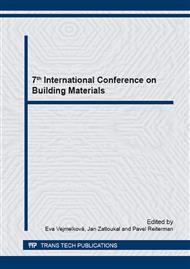p.151
p.155
p.161
p.167
p.173
p.179
p.185
p.191
p.197
The Effect of Elevated Temperature on High Performance Fiber Reinforced Concrete
Abstract:
High performance fiber reinforced concrete (HPFRC) became very popular material due to its high strength, elastic modulus, corrosion and fire resistance. However, detail description of HPFRC behaviour is necessary for its application and an effective building design and development. Here, also the fire safety of buildings must be considered. Therefore, the effect of elevated temperature on HPFRC is studied in the paper. For the reference material, experimental assessment of basic physical and mechanical properties is done. Then, the HPFRC samples are exposed to the temperatures of 600 and 800 °C respectively, and the effect of a high temperature exposure on material structure is examined. It is found that the applied high temperature loading significantly increases material porosity due to the physical, chemical and combined damage of material inner structure, and negatively affects also the pore size distribution.
Info:
Periodical:
Pages:
191-195
Citation:
Online since:
July 2015
Authors:
Price:
Сopyright:
© 2015 Trans Tech Publications Ltd. All Rights Reserved
Share:
Citation:


